A Year in the Streets: Resistance in the Bay in 2014
From the blockading of Google buses to the blockading of major freeways. From riots against white supremacy and police in Oakland to anti-tech and gentrification brawls in San Francisco, 2014 was an explosive year. Battles erupted in a variety of places and around various issues. Against surveillance, against the eviction of squats and homeless camps, against Israeli attacks on Gaza at the Port of Oakland, and in workplaces and neighborhoods across the region. While the bay changed for the worse: thousands were evicted and displaced, the cost of living and rent soared, poverty, deportations, and cuts to basic services grew, and police across the region continued to go on the offensive killing and brutalizing many; people fought back in new and exciting ways. This year in review looks at some of the key struggles and outbreaks of rebellion that shook the bay area to its core.
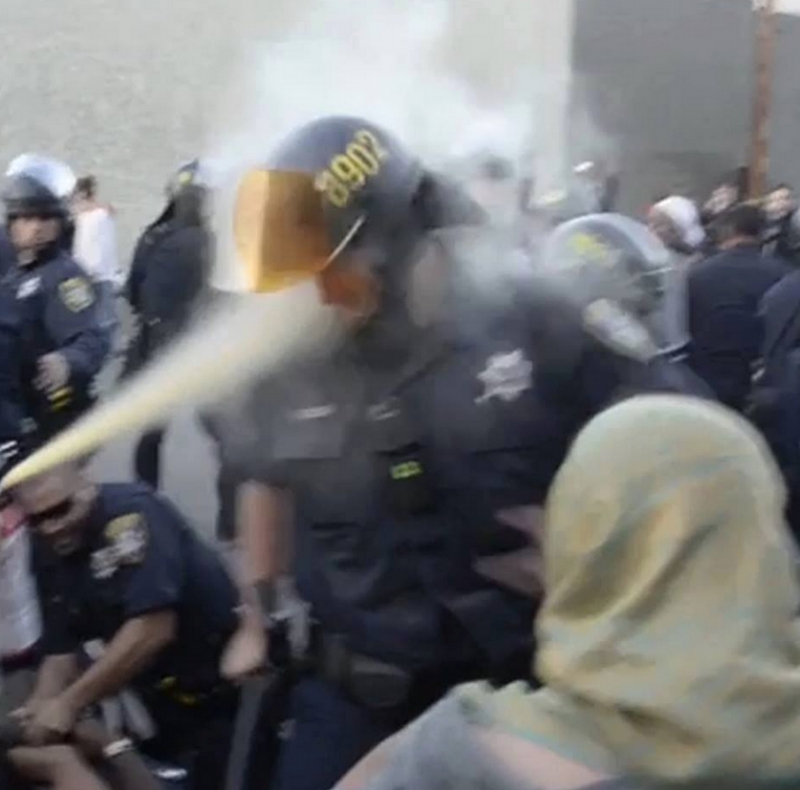

As 2013 drew to a close in downtown Oakland, people shot fireworks into the air outside of Glenn Dyer Jail as part of a global wave of noise demonstrations against prisons, incarceration, and the society that maintains them. Despite the dampening of the initial wave of energy generated by Occupy Oakland just two years earlier, there was still resistance that offered a glimpse at what lay just on the horizon. In the summer, for three-days riots raged in Oakland as freeways were blocked and businesses were attacked, after the acquittal of George Zimmerman for the murder of Trayvon Martin. In San Francisco, a struggle erupted at an urban farm that was slated for eviction to make way for condos, as people occupied the land and resisted eviction for close to a week calling the communal farm, “Gezi Gardens,” in solidarity with the ongoing riots in Turkey. At SF State, students marched against police who brutally assaulted a group of squatters staying at a friend’s dorm who had been evicted from a radical squat a day before. In Oakland, people took the streets and acted in solidarity with the California Prisoner Hunger Strike. In Berkeley, a small occupation began on the steps of the  historic Post Office in the downtown against its closure, which continues to this day. In Albany, just several miles south, a struggle began on the Albany Blub, against the eviction of a community of squatters who had called the land home for many years. Also in Albany, radical farmers continued actions at the Gill Track farm in the face of UC Berkeley authority. In Oakland, Port Truckers held mass assemblies, rallies, and staged a string of wildcat strikes which shut down the Port. Nearby in Santa Rosa, thousands took to the streets against the police killing of Andy Lopez, a 13 year-old Latino boy. In the San
historic Post Office in the downtown against its closure, which continues to this day. In Albany, just several miles south, a struggle began on the Albany Blub, against the eviction of a community of squatters who had called the land home for many years. Also in Albany, radical farmers continued actions at the Gill Track farm in the face of UC Berkeley authority. In Oakland, Port Truckers held mass assemblies, rallies, and staged a string of wildcat strikes which shut down the Port. Nearby in Santa Rosa, thousands took to the streets against the police killing of Andy Lopez, a 13 year-old Latino boy. In the San  Francisco Mission District, people held block parties which smashed Google bus piñatas to live anarchist hip-hop as they decried the rapid gentrification of the city. By the end of the year, Google buses in Oakland would be physically attacked as the blockading of tech shuttles would proliferate throughout the region.
Francisco Mission District, people held block parties which smashed Google bus piñatas to live anarchist hip-hop as they decried the rapid gentrification of the city. By the end of the year, Google buses in Oakland would be physically attacked as the blockading of tech shuttles would proliferate throughout the region.
But while radical action was starting to climb out of it’s post-Occupy rut, the bay area was continuing to undergo drastic transformations which only further immiserated the lives of poor, working, and oppressed people. As the tech boom continued to explode, thousands moved into San Francisco as rents rose enormously and landlords continued to use the Ellis Act to evict entire families. This industry changed the landscape of the entire city and continued into Oakland. Meanwhile, the populations of African-American, Latinos, and other people of color fell drastically across the bay area, as many were pushed into Antioch, Pittsburg, and  Stockton. The power of organized labor was put to the test and showed its limits, as BART workers went on strike, grinding the bay area to a halt. At the same time, both union bureaucrats and the State worked to keep AC Transit, BART, and also Port of Oakland Truckers from joining together in action. Meanwhile, the cost of living continued to rise, wages fell, deportations went up, hunger, poverty, unemployment, and homelessness grew (especially among children), and all the while the State continued to ramp up its repressive apparatus of spying and surveillance.
Stockton. The power of organized labor was put to the test and showed its limits, as BART workers went on strike, grinding the bay area to a halt. At the same time, both union bureaucrats and the State worked to keep AC Transit, BART, and also Port of Oakland Truckers from joining together in action. Meanwhile, the cost of living continued to rise, wages fell, deportations went up, hunger, poverty, unemployment, and homelessness grew (especially among children), and all the while the State continued to ramp up its repressive apparatus of spying and surveillance.
2014 was a year of explosive anger, highlighted most graphically against gentrification, displacement, and a white supremacist system of policing and incarceration. But 2014 was also a time of many different and varied struggles – and one of the most exciting things by the end of the year was to see these different veins of contestation coming together. This review will look at some of the struggles, actions, and social upheavals which rocked the bay area and how everyday people took part in them.
 “Cops and Condos Go Hand in Hand”
“Cops and Condos Go Hand in Hand”
At the heart of anarchist analysis of the world lies in the idea that systems of domination and exploitation are supported and made possible through State violence and coercion. The gentrification and housing crisis of San Francisco and the wider bay area is not simply just a problem of booming property values or the ‘hidden hand of the market,’ but also a very real push by racist policies and aggressive police departments to clear the streets of the poor and evict them from their homes. Without the State, those that own property and businesses have no power: there are always more workers than bosses, renters than landlords, prisoners than guards, and homeless people than Sheriffs. Supported by developers, in 2013 a coalition had been created called the “Clean Up the Plaza” Campaign, which sought to push the homeless, SRO tenants, and street people out of the BART plazas on 16th and Mission in San Francisco. In early January, an anarchist organized march took to the streets in the Mission to draw a connection between displacement and policing. The march drew a over 100 people and ended with speakers and the sharing of coffee and pastries, and helped set the stage for the tone of future actions and also made much needed connections in people’s heads between capitalism and the State.
But such actions linking gentrification along with the apparatus of policing weren’t taking place in a vacuum. Only a month earlier, people had begun to engage in the blockading of Google and other tech buses, both in San Francisco and then spreading to Oakland. After a Google bus was attacked and had its windows broken out at the West Oakland BART station while a banner was held reading “FUCK OFF GOOGLE” in front of the bus, national media descended on the protests, helping to highlight the ongoing massive wave of gentrification happening in the bay area as an actual crisis. The Google bus blockades continued throughout the year, often leading to standoffs with the police and impromptu marches.
 But while the blockades for a time created an (ironically) internet media storm and drew a lot of attention to gentrification in the bay area, another group Counterforce, also clearly anarchist, began to grab headlines as they launched protests outside of tech employees homes, starting with Anthony Levandowski, a Berkeley Google developer in January. By February, Counterforce related actions had spread to Seattle, as tech buses there were blocked and numerous communiqués were released detailing the connections between gentrification, the surveillance-State, and industrial civilization.
But while the blockades for a time created an (ironically) internet media storm and drew a lot of attention to gentrification in the bay area, another group Counterforce, also clearly anarchist, began to grab headlines as they launched protests outside of tech employees homes, starting with Anthony Levandowski, a Berkeley Google developer in January. By February, Counterforce related actions had spread to Seattle, as tech buses there were blocked and numerous communiqués were released detailing the connections between gentrification, the surveillance-State, and industrial civilization.
 In San Francisco, the group Eviction Free San Francisco began leading protests aimed at targeting specific landlords involved with evicting people under the Ellis Act. By the end of the year, such actions claimed success in keeping some people in their homes and also helped generate support for the use of direct action to evictions. The situation in San Francisco also continued to heat up, as wearers of Google Glass were openly harassed and attacked on the streets and in bars. Throughout the city, a culture was being normalized of intense hostility to the tech industry and yuppies. In late February, Vanguard Properties, LLC, was attacked in the Mission District which helps highlight this tension. A communiqué read:
In San Francisco, the group Eviction Free San Francisco began leading protests aimed at targeting specific landlords involved with evicting people under the Ellis Act. By the end of the year, such actions claimed success in keeping some people in their homes and also helped generate support for the use of direct action to evictions. The situation in San Francisco also continued to heat up, as wearers of Google Glass were openly harassed and attacked on the streets and in bars. Throughout the city, a culture was being normalized of intense hostility to the tech industry and yuppies. In late February, Vanguard Properties, LLC, was attacked in the Mission District which helps highlight this tension. A communiqué read:
Last night, on February 28th, the windows of Vanguard Properties in the Mission District were smashed out. Vanguard thought it was pretty funny to build some luxury condos on 24th, but we thought it was more funny for their property to get smashed. Vanguard thought it was pretty funny to buy foreclosed houses in Oakland and flip them at a profit. We think its more funny to bring the fight to the developers themselves. Greetings to everyone fighting the good fight.
 In April, another round of Google bus blockades took place both in San Francisco and in Oakland as part of a week of actions called under the moniker ‘Defend the Bay Area.’ Press agencies were quick to scream bloody murder as people climbed on top of a Google bus in Oakland and vomited over its windows. Later in April, Counterforce carried out a small demonstration outside of the home of Kevin Rose in San Francisco and used the action to demand that Google give them $3 billion to create autonomous, ecological neighborhoods. While the demand was laughable, it continued to generate a lot of press around Counterforce and gave a platform to the group’s anarchist ideas. In the summer,
In April, another round of Google bus blockades took place both in San Francisco and in Oakland as part of a week of actions called under the moniker ‘Defend the Bay Area.’ Press agencies were quick to scream bloody murder as people climbed on top of a Google bus in Oakland and vomited over its windows. Later in April, Counterforce carried out a small demonstration outside of the home of Kevin Rose in San Francisco and used the action to demand that Google give them $3 billion to create autonomous, ecological neighborhoods. While the demand was laughable, it continued to generate a lot of press around Counterforce and gave a platform to the group’s anarchist ideas. In the summer,  Counterforce staged a small demonstration outside of the home of Thomas Fallows, another Google employee and Ellis Act evictor. Eviction Free SF staged similar demonstrations, including a large march on Vanguard properties who was threatening to evict Benito Santiago, a key Eviction Free SF organizer. Also in April, Eviction Free SF began targeting the home of Jack Halprin, a Google lawyer who is trying to evict a San Francisco teacher from her home under the Ellis Act, and the battle is ongoing. As one Counterforce communiqué reads which highlights the anger of this time:
Counterforce staged a small demonstration outside of the home of Thomas Fallows, another Google employee and Ellis Act evictor. Eviction Free SF staged similar demonstrations, including a large march on Vanguard properties who was threatening to evict Benito Santiago, a key Eviction Free SF organizer. Also in April, Eviction Free SF began targeting the home of Jack Halprin, a Google lawyer who is trying to evict a San Francisco teacher from her home under the Ellis Act, and the battle is ongoing. As one Counterforce communiqué reads which highlights the anger of this time:
Capital exudes an exoskeleton wherever it conquers and colonizes. Buildings rise, homes fall, populations are displaced, and the world hardens into a constellation of dead shells, replicating infinitely on a finite planet. We are going to stop this supposedly infinite expansion of capital, no matter how overwhelming our opponent may seem, no matter how desperately they try to flee the planet. Their project is not total, nor is it complete, and there is still much time to defeat it. The cracks are already appearing everywhere, we are simply pointing them out. As we have said before, the revolution that is coming will be vast, so expect no pity from it.
Autonomous actions against gentrification continued on both sides of the bay. In April, the condo officers of Vida in San Francisco were attacked. A communiqué posted online read:
Last night we attacked the Sales office for the in-construction Vida Condos on Mission St. We added a new heavy-duty lock to their security gate and hit their facade with paint. this was just one small act of hostility in what will hopefully soon be a storm. We did this because they make a mockery of life. Despite their name, they offer only death with the mask of life. These developments, and all the others, deserve much more.
Not long after, another communiqué posted to AnarchistNews.org claimed responsibility for an attack on upscale businesses in West Oakland:
Early on Monday morning, locks were glued at Dogtown Development and at a new fancy coffee shop in the lower bottoms. The walls of Dogtown Development were painted to read: “Your Progress Reeks of Death.” The coffee shop was painted to read “Yuppies Eat Shit.” Fuck the developers. Fuck development. Attack.
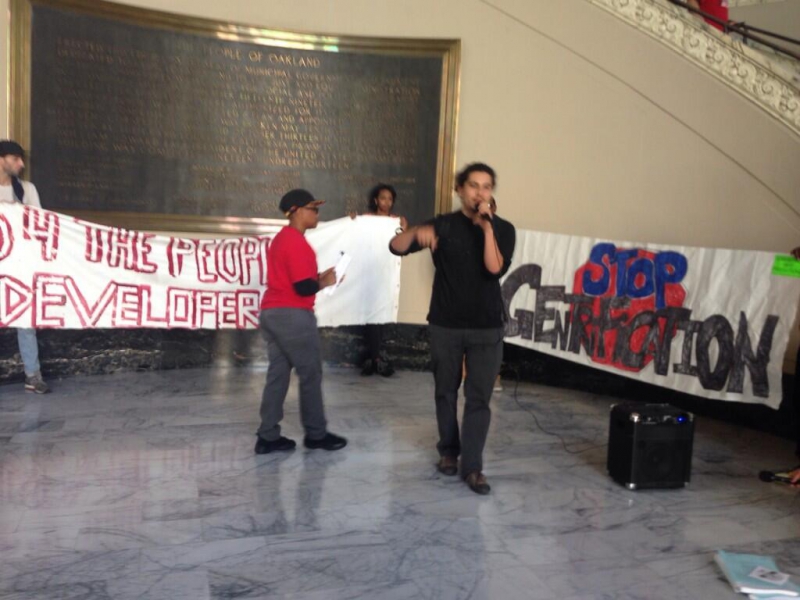 In early 2014, attention had focused on a proposed condo development at 16th and Mission, which threatened to displace and transform one of the last working-class strongholds in the largely Latino neighborhood. A coalition was formed and various marches and block parities took place and a sizeable group also held a disruptive action inside the small offices of Maximus, LLC, the group responsible for the project. Several days later in Oakland, a large group of people took to the streets and disrupted a City Council meeting which was posed to pass the West Oakland Specific Plan (WOSP), which aimed to bring thousands of new residents into Oakland while making the area safe for business investors. The group Advance the Struggle wrote in a lengthy piece about the WOSP:
In early 2014, attention had focused on a proposed condo development at 16th and Mission, which threatened to displace and transform one of the last working-class strongholds in the largely Latino neighborhood. A coalition was formed and various marches and block parities took place and a sizeable group also held a disruptive action inside the small offices of Maximus, LLC, the group responsible for the project. Several days later in Oakland, a large group of people took to the streets and disrupted a City Council meeting which was posed to pass the West Oakland Specific Plan (WOSP), which aimed to bring thousands of new residents into Oakland while making the area safe for business investors. The group Advance the Struggle wrote in a lengthy piece about the WOSP:
The West Oakland Specific Plan is the City of Oakland’s plan to help developers and incoming high wage populations speed up the accumulation of capital in Oakland. It essentially acts as a one stop shop for financial and retail capitalists to invest in West Oakland without having to go through the “nuisance” of making Environmental Impact Reports – EIRs – or dealing with zoning regulations. Instead of having new developments require zoning, and environmental impact regulations, the WOSP does it all for them and therefore saves money for the developers, retail chains, and financial interests seeking to build in and make massive profits in West Oakland. It is the state facilitating the accumulation of capital and dispossessing long term, and historically black, residents in the process by bringing in new investment that will increase property values while doing nothing to keep rents for existing residents from going up.
The WOSP highlights four “Opportunity Sites” as the specific areas of West Oakland to be developed. The Four areas are the Mandela/West Grand area, the San Pablo corridor, the area around the BART station on 7th Street and the area next to the Port of Oakland around 3rd Street. These “Opportunity Sites” are determined to be the specific places where transit, new housing, light industrial and retail outlets will be developed. In order to “revitalize” these areas, the architects of WOSP have identified various barriers to development such as “graffiti,” “homeless encampments,” “crime of all types,” and “blight.” In the eyes of the architects of WOSP, once the barriers to development are gone there will be a flourishing of “new growth”
 Unsurprisingly, WOSP was passed and very quickly fences went up around the San Pablo corridor at small plazas frequented by the homeless. In December however, a group of people marched to these sites and destroyed the fences to the cheers of those on the street who quickly came in to reclaim the area. Bay Area Intifada was live at the scene and conducted interviews with participants and wrote this report:
Unsurprisingly, WOSP was passed and very quickly fences went up around the San Pablo corridor at small plazas frequented by the homeless. In December however, a group of people marched to these sites and destroyed the fences to the cheers of those on the street who quickly came in to reclaim the area. Bay Area Intifada was live at the scene and conducted interviews with participants and wrote this report:
On Saturday morning, community members, with the blessings of Triangle Park residents, removed a fence put up by the the city just days before. The park is a community space where people mingle, snooze, break bread, play chess and–for some homeless people–can finally rest their feet. The city put up the fence to push park residents and visitors out of the community gathering space, angering park residents, nearby neighbors and other Oaklanders. People are drawing a clear connection between the fence and the city’s ongoing efforts to gentrify Oakland through the displacement, murder and harassment of black, brown and homeless communities.
Communiqués continued to surface claiming responsibility for attacks on yuppie properties and vandalism often happened without being claimed. Local media in the East Bay Express also tried to link an attack on Kilowat Coffee, (windows were broken and “EAT SHIT YUPPIES” was painted on the night that the WOSP was passed), a new coffee store in West Oakland, with the FireWorks website, citing a poster that was hosted on the website that encouraged vandalism to gentrifying businesses as evidence. Also in June, around the same time as a block party in the Mission against displacement, individuals slashed the tires to a Google van. A communiqué posted on indybay.org read:
[S]aturday the 14th, a few people slashed the tires of a google shopping express delivery van when it was stopped in traffic in the Mission District. the driver was so out of it they didn’t even notice and drove off slowly with the rest of the vehicles. its not clear where the truck finally broke down or how much the delivery schedule was affected but another truck would be needed to complete the route. we now declare open season on every vehicle connected to the gentrifying tech companies. go forth, comrades! to a world without commodities, money, or exploitation…
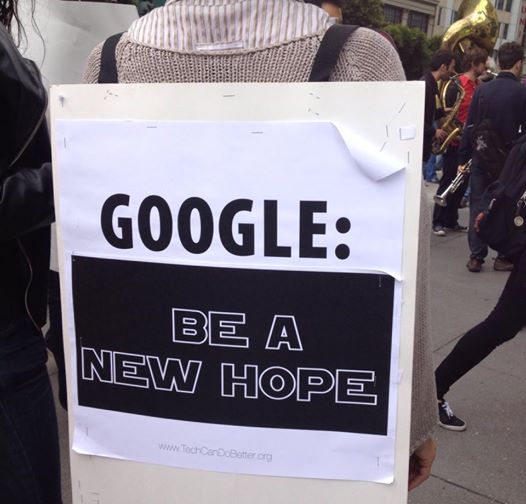 In late June, protests also occurred around tech conventions organized by Google, however much of these protests were extremely limited by liberal delusions of “tech being a force for good.” Cindy Milstein commented:
In late June, protests also occurred around tech conventions organized by Google, however much of these protests were extremely limited by liberal delusions of “tech being a force for good.” Cindy Milstein commented:
But too many of the comparatively tiny group of eviction resisters, tenants rights folks, and labor organizers were chanting and speaking about an “evil” versus “good” Google, as if it’s simply a matter of a few bad eggs. Too many were asking the same force, the same lord and master, that is ruining most of the planet in the interest of power for the few to suddenly, somehow, create a world for us all, with food, homes, health care, dignity, etc., for all. Indeed, the overarching demand for this protest was, “We call upon Google to be a good neighbor,” as if cozy coexistence with some of the greatest power consolidation in human history, and greatest inequality and injustice, is the neighborly aim.
 Despite their sometimes Leftist limitations, these anti-gentrification actions informed the exploding riots and demonstrations against police terror on the streets of Oakland and San Francisco in the fall and winter, and are by no means anywhere from over. For many, a signal of the growing rage and discontent at policing and also the tech industry generated displacement came from an unlikely event – the Giants winning yet another World Series in October. As thousands of people took to the streets across San Francisco, they clashed with police, erected street barricades, attacked condo developments, tech buses, property management buildings, and wrote graffiti linking Alex Nieto’s (a Latino man killed by SFPD several months earlier) murder with the ongoing struggle happening in Ferguson. As Roverto Lavato wrote:
Despite their sometimes Leftist limitations, these anti-gentrification actions informed the exploding riots and demonstrations against police terror on the streets of Oakland and San Francisco in the fall and winter, and are by no means anywhere from over. For many, a signal of the growing rage and discontent at policing and also the tech industry generated displacement came from an unlikely event – the Giants winning yet another World Series in October. As thousands of people took to the streets across San Francisco, they clashed with police, erected street barricades, attacked condo developments, tech buses, property management buildings, and wrote graffiti linking Alex Nieto’s (a Latino man killed by SFPD several months earlier) murder with the ongoing struggle happening in Ferguson. As Roverto Lavato wrote:
For several unforgettably exquisite hours last night, celebrating the San Francisco Giants victory on 24th Street felt musical, like a mix between a peasant land takeover, the L.A. riots and an Afro-Latin festive…
The streets were literally ours. Contrary to the predictable and barely veiled racist, look-at-these-violent-colored-people denunciations by mostly white bloggers and journalists tasked with showing us the difference between “good” Giant fans and “bad,” the streets looked quite different from the drunken orgy of violence they painted.
A text entitled, “We Welcome the Fire, We Welcome the Rain,” remarked:
[I]t is worth highlighting that the character of the sports riot felt different than the two previous instances. The violence of the night was significantly more targeted and specific: development offices and police vehicles trashed, the police hit with waves of projectiles, an under-construction condo site attacked and then nearly set alight, the names of those killed by police ran across the walls of the Mission. Though only for a night, within the sports riot one could see the preconditions for a storm of refusal.
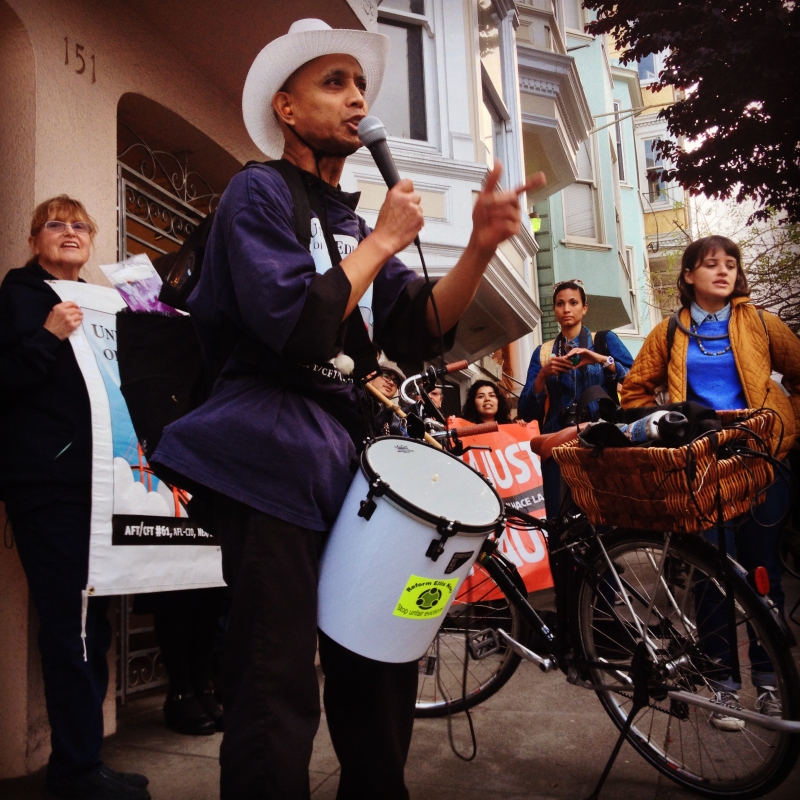 Actions continue in San Francisco, with pickets against landlords, mass marches, protests against evictions, and continuing blockades of tech buses happening semi regularly. Eviction Free SF saw a big win in September, when the Ellis Act eviction of several tenants, including key organizer Benito Santiago, was stopped. Only a month before, the group had briefly occupied a Vanguard Properties office. By the end of the year, the group could claim even more victories. As Benito stated:
Actions continue in San Francisco, with pickets against landlords, mass marches, protests against evictions, and continuing blockades of tech buses happening semi regularly. Eviction Free SF saw a big win in September, when the Ellis Act eviction of several tenants, including key organizer Benito Santiago, was stopped. Only a month before, the group had briefly occupied a Vanguard Properties office. By the end of the year, the group could claim even more victories. As Benito stated:
When I received the Ellis Act notice, I thought we had to be out immediately. I couldn’t fathom it. I’ve been living there for 37 years, and have nowhere else to go. It was then that I realized, all that I could do, was fight back to stay in my home. This is my life.
 The end of 2014 also saw the closing of Local’s Corner, the target of numerous graffiti crew and anarchist attacks for their role in gentrification and also discriminating against Latinos. The tech industry continued to grab headlines as it embarrassed itself and alienate many, such as the now famous Airbnb soccer fiasco. Over all, in 2014 the anti-gentrification battles on both sides of the bay could claim some victories and grew in size, although a more generalized mode of resistance still has not materialized and the rate of displacement seems astronomical. Still, the symbolic actions that began with the Google bus blockades have helped to manifest various struggles that seek to use direct action to fight existing conditions. Hopefully, these tactics can be picked up by everyone fighting eviction and displacement and grow across the social terrain. As the actions at the Giants riot also highlight, anger at the tech industry has also become extremely widespread and highly palpable. Getting organized and continuing to physically fight, attack, and blockade will only help in this anger continuing to explode.
The end of 2014 also saw the closing of Local’s Corner, the target of numerous graffiti crew and anarchist attacks for their role in gentrification and also discriminating against Latinos. The tech industry continued to grab headlines as it embarrassed itself and alienate many, such as the now famous Airbnb soccer fiasco. Over all, in 2014 the anti-gentrification battles on both sides of the bay could claim some victories and grew in size, although a more generalized mode of resistance still has not materialized and the rate of displacement seems astronomical. Still, the symbolic actions that began with the Google bus blockades have helped to manifest various struggles that seek to use direct action to fight existing conditions. Hopefully, these tactics can be picked up by everyone fighting eviction and displacement and grow across the social terrain. As the actions at the Giants riot also highlight, anger at the tech industry has also become extremely widespread and highly palpable. Getting organized and continuing to physically fight, attack, and blockade will only help in this anger continuing to explode.
 Bulb Autonomous Zone
Bulb Autonomous Zone
While the issue of gentrification in the bay area was being brought to the forefront, another struggle against displacement was also coming to a head in the small town of Albany, just south of Berkeley. The Albany Bulb, a former landfill and home to a community of up to 70 squatters as well as a haven for off-leash dogs, hikers, and rebel artists, was facing an eviction attempt which began in the summer of 2013. At the end of that year, the struggle had intensified and used a variety of tactics in order to halt the removal of the residents. The eviction was backed by local elites and the Sierra Club, all which sought to cleanse the Bulb of everything which made it popular. From open assemblies, out-door concerts, day long festivals and history tours, to rock barricades and police blockades, anarchists and other radicals worked to draw in the public to the struggle and also physically stop the eviction. In January of 2014, this battle continued with marches and campouts on Salono Ave. with short occupations, film showings, and art walks happening through the spring.
 By April of 2014 however, the situation at the Albany Bulb reached an endgame. The city of Albany offered to pay out $3,000 to those living on the Bulb in exchange for leaving the land and agreeing to not step foot back on the area that had been their homes for several years. Most of those living on the Bulb took the money, except for three residents, who held off further eviction for several more weeks. Supporters then launched an ongoing camp-out and support campaign which created rock barricades, did Copwatch when police came onto the land, locked down to bulldozer equipment, and tried to support those still living on the Bulb as best as possible. Then, in an early morning raid in late May, pigs from various agencies with guns drawn raided the last camp on the Bulb, targeting two residents, Amber and Phyl, two of the most outspoken organizers involved in the struggle, and arrested them along with a supporter. Two young anarchists were also arrested the day after on minor violations which were later dropped, but were given stay away orders. One article described the raid as such:
By April of 2014 however, the situation at the Albany Bulb reached an endgame. The city of Albany offered to pay out $3,000 to those living on the Bulb in exchange for leaving the land and agreeing to not step foot back on the area that had been their homes for several years. Most of those living on the Bulb took the money, except for three residents, who held off further eviction for several more weeks. Supporters then launched an ongoing camp-out and support campaign which created rock barricades, did Copwatch when police came onto the land, locked down to bulldozer equipment, and tried to support those still living on the Bulb as best as possible. Then, in an early morning raid in late May, pigs from various agencies with guns drawn raided the last camp on the Bulb, targeting two residents, Amber and Phyl, two of the most outspoken organizers involved in the struggle, and arrested them along with a supporter. Two young anarchists were also arrested the day after on minor violations which were later dropped, but were given stay away orders. One article described the raid as such:
By May 2014, those still living on the Bulb feared eviction at any moment while risking misdemeanor charges as the tickets for illegal camping piled up. Small crews of supporters camped out in solidarity, watching and monitoring police and attempting to starve off an eviction. But with the majority of residents now having left the Bulb, (many now living under a nearby freeway overpass – not being able to afford a place to live in up-scale Albany), the completion of the eviction was imminent. In the early hours of Thursday, May 29th, police from Albany and Berkeley along with Sheriffs raided Amber and Phyl’s camp, arresting them and one supporter. In an interview with the Contra Costa Times, Amber described the raid on her home, which involved 20-30 officers: “They actually had assault rifles, with their hands on the triggers. They didn’t have them pointed at us but it was scary enough.”
While the Albany Bulb struggle was not successful ultimately in stopping the eviction – at the same time it showed the power of a group of people willing to stop a small police force from enforcing property relations in a rugged environment. From rock barricades to human blockades, construction equipment and police vehicles were kept from entering the area on numerous occasions. One person even told us that city officials once asked, “What will the anarchists do?,” in response by this or that move by the city. Despite losing the fight against the evictions, Bulb defenders were still able to get $3,000 for most of those living on the Bulb, a number which would have been unimaginable several months before and also bought those forced to relocate much more time before they had to move.
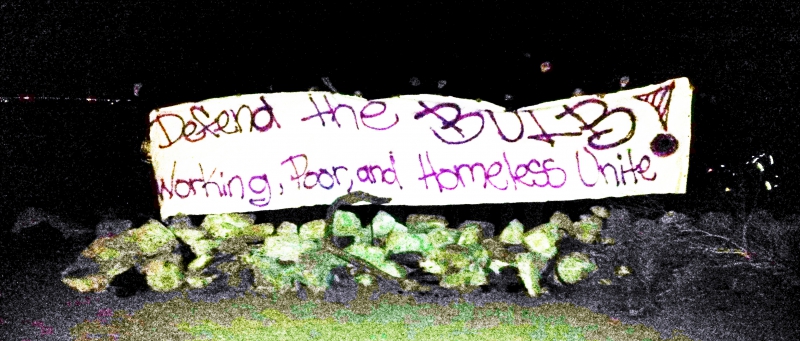
Domain Awareness Center
Despite protests at packed City Council meetings, the Oakland City Council in late 2013 decided to go ahead with plans to create the “Domain Awareness Center,” a central hub for the collection of real time video fed through CCTV cameras which would filter, track, and compile everything from license plates to social media. Despite being packaged as a tool to reduce crime in Oakland, internal documents and emails showed that the project was primarily aimed at surveilling and stopping future potentially revolutionary movements. The DAC was supposed to be a flagship model of surveillance in a large scale urban city that elites could use as a template in other locations. While it was clearly aimed at radicals and protest movements, the implications for everyday life were extremely clear. As an article on FireWorks stated on growing opposition to the DAC:
As the Lighthouse Mosque of Oakland wrote in a recent piece against the DAC, “From Oakland to New York City the Muslim community has been spied on whole scale, we have had infiltrators and informants in our mosques, we have been singled out at political protests and we have even had people in our community entrapped by the FBI.” The Mosque goes on to mention, “…[O]ur members have been racially, religiously, and politically profiled and targeted during protests, such as the case of the Trayvon 2 and Harun Arsalai, who was pulled out of a crowded street at Occupy Oakland when he was wearing a headband with Arabic writing on it.” According to a recent Mother Jones article, “Ever since 9/11, counter-terrorism has been the FBI’s No. 1 priority, consuming the lion’s share of its budget—$3.3 billion, compared to $2.6 billion for organized crime—and much of the attention of field agents and a massive, nationwide network of informants. After years of emphasizing informant recruiting as a key task for its agents, the bureau now maintains a roster of 15,000 spies—many of them tasked…with infiltrating Muslim communities in the United States. In addition, for every informant officially listed in the bureau’s records, there are as many as three unofficial ones, according to one former high-level FBI official, known in bureau parlance as “hip pockets.””
An anarchist organized march against police repression and surveillance was also organized in West Oakland, which marched on the proposed site of the DAC. A communiqué from the march read:
On Saturday, February 22nd, dozens of opponents to the increasing surveillance and policing of Oakland gathered in DeFremery Park. After a brief speaker, detailing the plans for the DAC, a group took the street with a banner declaring “No Cameras In Our Community.” The group confronted the police and then marched to the Emergency Command Center, and then dispersed at City Hall.
 The struggle against the DAC unfortunately largely stayed regulated to the confines of the City Council chambers – with several notable exceptions. Even in themselves, these packed meetings were often disorderly. Police were also on guard, video-taping individuals and the crowd which only further infuriated people. Marches took place after the meetings which made their way through the streets and often went by the site of the proposed DAC building in downtown Oakland. Such pressure, along with the growing anger in the US over government spying and mass surveillance, pushed the council to scrap the initial plans for the project and keep the DAC contained to the Port of Oakland.
The struggle against the DAC unfortunately largely stayed regulated to the confines of the City Council chambers – with several notable exceptions. Even in themselves, these packed meetings were often disorderly. Police were also on guard, video-taping individuals and the crowd which only further infuriated people. Marches took place after the meetings which made their way through the streets and often went by the site of the proposed DAC building in downtown Oakland. Such pressure, along with the growing anger in the US over government spying and mass surveillance, pushed the council to scrap the initial plans for the project and keep the DAC contained to the Port of Oakland.
 Despite activists claiming victory, many pointed out that the DAC could still be a very real threat to those who work at the Port of Oakland. Also, many sections of the city were already under heavy surveillance and new systems were incorporating DAC type technology all the time. As Jack Heyman, a militant Longshoreman and retired member of ILWU Local10, stated in an interview with FireWorks in July:
Despite activists claiming victory, many pointed out that the DAC could still be a very real threat to those who work at the Port of Oakland. Also, many sections of the city were already under heavy surveillance and new systems were incorporating DAC type technology all the time. As Jack Heyman, a militant Longshoreman and retired member of ILWU Local10, stated in an interview with FireWorks in July:
The DAC is a product of the national security legislation that mushroomed after 9/11. Port workers have been shackled with government regulations that force them carry a Transport Workers Identification Card or TWIC card. Under the guise of fighting terrorism, the U.S. government has cast a broad definition of “terrorism” mainly directed against workers, racial minorities and immigrant workers which encompasses just about all workers in the port. Strikes by port workers which stop the flow of cargo in global trade could be considered “terrorist acts.”
Furthermore, port demonstrations against wars like the U.S. imperialist wars in Iraq and Afghanistan, [calling for justice in the case of Oscar Grant], or the 2010 protests against Israeli attacks on a humanitarian aid flotilla to Gaza or the present Zionist slaughter there could also be deigned illegal acts supporting “terrorism.” In the present situation many port truckers who are immigrant workers could be targeted by the DAC and lose their jobs and even deported. Thousands of port workers have already lost their jobs under the TWIC provision of the Maritime Transportation Security Act of 2002. Some were deported.
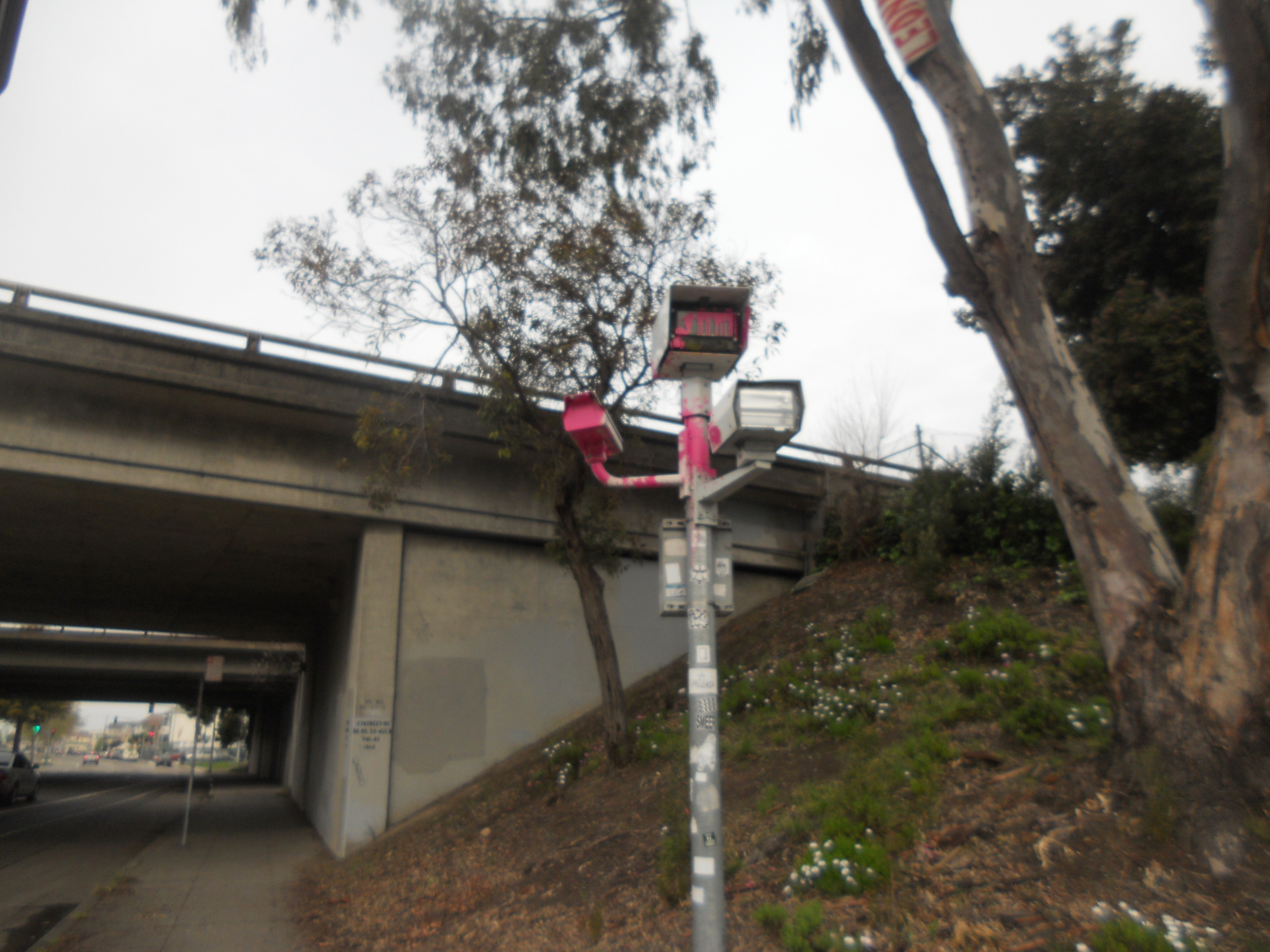 While mass disruptive actions aimed at either stopping the City Council from meeting or the construction of surveillance technologies in the first place never materialized, other people continued to take autonomous action. Starting in early December of 2013, anonymous individuals carried out a string of actions against CCTV cameras in Oakland which sought to physically attack the apparatus of surveillance as well as keep the pressure on. One communiqué posted on indybay.org after the decision by the City Council to keep the DAC restricted to the Port of Oakland stated:
While mass disruptive actions aimed at either stopping the City Council from meeting or the construction of surveillance technologies in the first place never materialized, other people continued to take autonomous action. Starting in early December of 2013, anonymous individuals carried out a string of actions against CCTV cameras in Oakland which sought to physically attack the apparatus of surveillance as well as keep the pressure on. One communiqué posted on indybay.org after the decision by the City Council to keep the DAC restricted to the Port of Oakland stated:
Honestly, victory wasn’t even theoretically on the table, as “Phase One” of the DAC has already been approved, and phase one includes the integration of city traffic cameras. There is now no legal avenue to even pretend to fight the capture, aggregation, and analysis of our images and personal information. Is all lost? Are the wingnuts right? Should we start saving up for some land in Idaho and build underground tunnels or else submit to the encroaching fascist state?
Well, my dears, We believe that there is still hope yet. The government of our fair city and it’s police department have proven themselves to be rather inept, no matter what toys they are given by the feds. There are only forty or so of these traffic cameras. The city of Oakland has a limited budget allocated for this project. We can nullify the DAC.
Another post in late December on indybay.org read:
A surveillance camera at 35th & Market streets in West Oakland seemed to be painted over. The camera is one of the freeway traffic cameras which are the only non-port cameras connected to the Domain Awareness Center. The nearby camera a block north had been similarly targeted by “TWAT” last March.
Such actions pointed to a reality – State surveillance is a physical apparatus which can be attacked and destroyed. Sadly, the anti-surveillance actions stayed very small and isolated. We must ask ourselves, why was this so? Moreover, with the bar currently being raised through riots and freeway blockades, the next time around the elites want to enact such a plan, what are we going to do differently?
 Trayvon 2 Trial
Trayvon 2 Trial
In March, two young men began lengthy court proceedings steaming from arrests during the Trayvon rebellions that occurred in Oakland during the summer of 2013. The two young men, Hannibal Shakur and Tanzeen Doha, both people of color and both Muslims, drew a wide cross-section of support from various political circles, spanning black liberation groups, those in the local Muslim community, and anarchists and anti-capitalists. The Anti-Repression Committee, a group formed during Occupy Oakland that provided jail support, connected people arrested at demonstrations with lawyers, and bailed people out of jail issued a statement in solidarity Tanzeen and Hannibal, who became known as the ‘Trayvon 2:’
The Bay Area Anti-Repression Committee (BARC) stands in solidarity with the Trayvon 2 in their fight against racist profiling and prosecution by Oakland’s Police Department (OPD) and District Attorney’s Office.
The Bay Area Anti-Repression Committee is outraged not only by these baseless allegations, but also by the clearly evident racist and Islamophobic targeting at work in this case. Hannibal and Tanzeen, two young Muslim men of color, are the only individuals facing felony prosecution for their participation in the Trayvon Martin protests in Oakland.
 By the end of 2014, after a trial in which police were unable to bring any evidence to bear against the Trayvon 2, charges against both young men were dropped. Throughout the various court dates, people came out in support, often packing the court room. In an interview, Hannibal Shakur shared his thoughts on the case:
By the end of 2014, after a trial in which police were unable to bring any evidence to bear against the Trayvon 2, charges against both young men were dropped. Throughout the various court dates, people came out in support, often packing the court room. In an interview, Hannibal Shakur shared his thoughts on the case:
There’s been a lot of pressure on the DA to clamp down on protesters. They’re looking for a scapegoat to make them think organizing marches isn’t worth it. One of the discouragements for corporations to invest in developing these areas is there’s such a history of protests here. It represents an uncertain financial future for corporations who want to come in and advance capitalism.
We have such a mobilized community: students, workers, even different churches and mosques. The movement keeps the rapid development at bay, because there are community ties holding things together. They want certain individuals. Get those individuals who inspire people with a political analysis and offer a platform for people to unify.
We’re both Muslims. We believe there’s something we’re accountable to that’s bigger than the world that we’re living in. We’re not afraid of the unjust system. It’s powerful and massive, but still we find ways to resist and triumph, despite the position the system has placed us in this society.
Check out a recorded interview with Hannibal on his case and broader political issues, as well as this excellent documentary made by WeCopwatch.
We Are Wildcats, Hear Us Roar
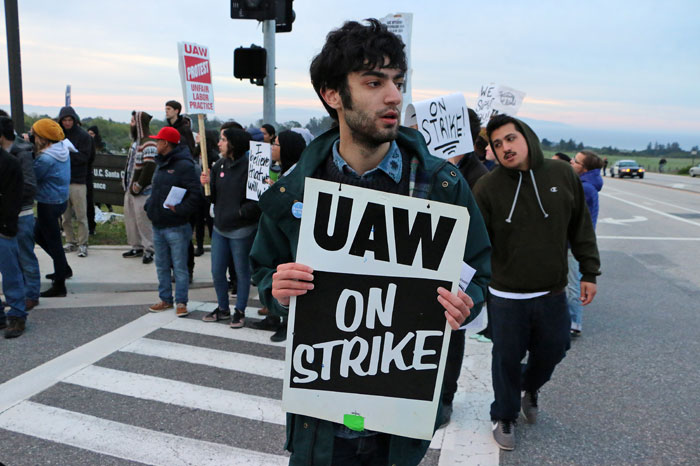 While the transit general strike of 2013 never materialized, much to the chagrin of labor bureaucrats and bosses alike, and to the dismay of transit workers who faced concessionary contracts, other labor battles exploded in 2014 in new and exciting ways. In April, graduate students at University of California (UC) campuses across the state lead a series of strikes which drew wide spread support from students and other workers, and in Santa Cruz faced repression and arrests from the police. Some striking UAW workers shared their thoughts:
While the transit general strike of 2013 never materialized, much to the chagrin of labor bureaucrats and bosses alike, and to the dismay of transit workers who faced concessionary contracts, other labor battles exploded in 2014 in new and exciting ways. In April, graduate students at University of California (UC) campuses across the state lead a series of strikes which drew wide spread support from students and other workers, and in Santa Cruz faced repression and arrests from the police. Some striking UAW workers shared their thoughts:
Perhaps our peers are right: perhaps we strikers are the futureless, the luckless, the unspecial. To which we should reply—Yes, and so are you! Of course, logic dictates that some of us will be retained by the academy as its favored prodigies; that some of us will best our peers on a tightening job market; that odds will always (ever) be in someone’s favor. But this is not a logic, not a system, that we could ever willingly endorse. The university profits by our atomization, our disunity; it encourages our delusions of specialness, our faith in anointment and meritocratic providence; it thrives on our belief, against every shred of evidence, that we are not workers. We are striking because we are workers. We are striking, not to withdraw our labor arbitrarily, but so that we can find each other outside the walls of the academy. There are no fair labor practices in the academy or anywhere else; there are only the gains we win for ourselves, together, fighting.
 In June, MUNI bus drivers who are legally not allowed to strike, staged a sick-out after voting down a concessionary contract. The sick-out continued over the next couple days and caused chaos throughout the transit system and pointed towards the capacity of workers to self-organize outside of the union apparatus.
In June, MUNI bus drivers who are legally not allowed to strike, staged a sick-out after voting down a concessionary contract. The sick-out continued over the next couple days and caused chaos throughout the transit system and pointed towards the capacity of workers to self-organize outside of the union apparatus.
In September, across racial and language lines, SF Ironworkers carried out a wildcat strike in protest of low wages. The action was inspiring because it brought many different workers together and also because it articulated anger many workers had (who were all working to construct condos in the downtown) that they could not afford to live where the work, much less buy the condos they were making for the rich.
At the end of October, largely immigrant recycling workers in Oakland successfully won a strike. The strike was the culmination of protests and marches, all aimed at getting higher wages and respect on the job. Some Teamster garbage drivers also called out sick as to not break the picket lines although the union refused to officially honor the strike.
 In November and December, drivers for Lyft and Uber staged protests. Taxi drivers near SFO took part in massive slow-downs against the for-mentioned tech companies for negatively affecting their business, causing massive disruption.
In November and December, drivers for Lyft and Uber staged protests. Taxi drivers near SFO took part in massive slow-downs against the for-mentioned tech companies for negatively affecting their business, causing massive disruption.
Minimum wage earning workers at fast-food restaurants continued to launch strikes, as did bay area Wal-Mart workers. Voters in Oakland and San Francisco approved measures that over a period of years would raise the minimum wage, however the new wage increases will still not allow workers to keep up with rising costs.
Whole Foods workers with the anti-capitalist union the Industrial Workers of the World (IWW) also began a series of actions aimed at gaining higher wages. Actions by the IWW so far have lead to Whole Foods giving workers a raise. As one worker wrote in an interview with FireWorks:
The organizing has been going on in some form for about 5 years. In the early days the numbers were small, about 3-4 long time workers who would advocate for workers and meet weekly outside of work. In the last three years the numbers grew to a solid 7-9 worker-organizers, committed to organizing on the job.
The goal is for workers to feel empowered on the job. We are a union when we act like a union, we presented the demands as a group and that is the source of our power. Although there are wobblies working at the store, membership is voluntary and will continue to remain that way. Better working conditions and the wage increase across the board is the start of workers feeling empowered on the job.
Over the years workers have won demands around scheduling, time off, and food employees can purchase at a discounted price (aka spoilage or “garbage food”). As issues arose and collective actions were successful at winning demands, workers began to see what could be achieved by standing together. These “smaller” actions set the stage for the demands we presented on Nov. 6th.
Student Occupations and Actions
Struggles broke out on campuses for higher education throughout 2014, centered in the UC system against new a Chancellor, Janet Napolitano and tuition raises later in the year, in San Francisco, against threats to close a junior college in the Mission District and changes in the schools tuition payments, and in the east bay at local high schools against police murders.
 In February, students occupied for several days the Blum Center building against Janet Napolitano’s policies at UC Berkeley. While the occupation was short, it ended without arrests and showed that the spirit of the student occupation movement of 2009 was still alive and well. From a FireWorks article:
In February, students occupied for several days the Blum Center building against Janet Napolitano’s policies at UC Berkeley. While the occupation was short, it ended without arrests and showed that the spirit of the student occupation movement of 2009 was still alive and well. From a FireWorks article:
UC Berkeley students and allies…are demanding the resignation of Janet Napolitano, who has recently become the President of the University of California (UC) system. Napolitano is a member of the Democratic Party, former Governor of Arizona from 2003 to 2009, an architect of the “Secure Communities” deportation campaign, and was the former Secretary of the Department of Homeland Security.
[During the occupation] there were about 11 people who were locked inside the Blum office building. [This began when] several hundred people (upwards of 1,000 one participant told me), marched throughout the campus until they came to Blum Hall close to the north gate near Hearst and Euclid in Berkeley. At that time, people walked into the office and locked the doors. There appeared to be several chains on the doors to prevent police from coming inside.
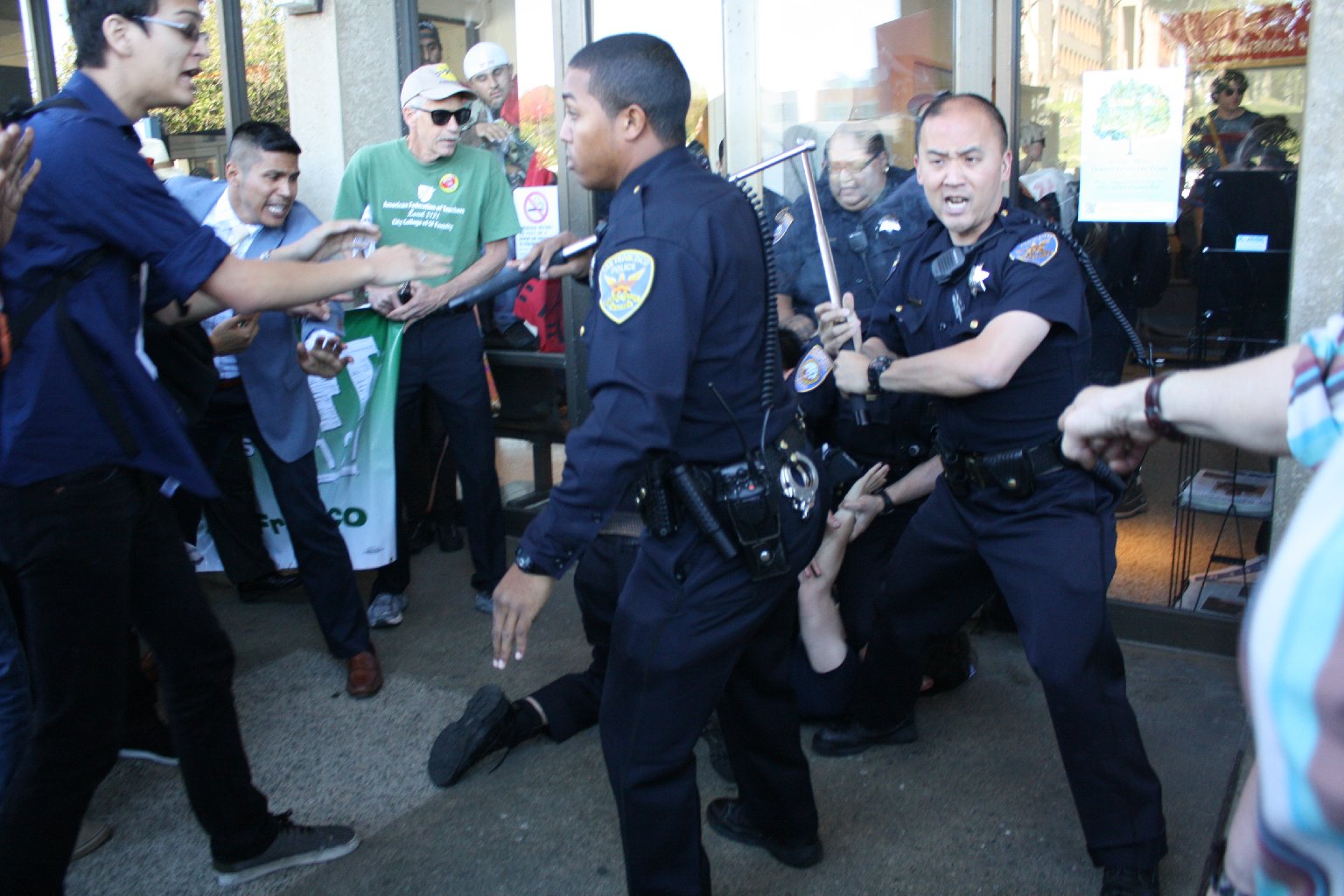 In March, violent clashes erupted at City College in San Francisco after proposed changes in tuition payment, as students attempted to conduct a sit-in in one of the buildings. Students faced police attacks from pepper-spray and batons and occupied an administration building afterwards. The situation at City College continues to remain tenuous, as the school fights to remain accredited amid further protests. A judge is scheduled to rule on the issue in January of this year.
In March, violent clashes erupted at City College in San Francisco after proposed changes in tuition payment, as students attempted to conduct a sit-in in one of the buildings. Students faced police attacks from pepper-spray and batons and occupied an administration building afterwards. The situation at City College continues to remain tenuous, as the school fights to remain accredited amid further protests. A judge is scheduled to rule on the issue in January of this year.
 Around the same time as a grand jury was set to deliver its verdict of non-indictment in St. Louis for Darren Wilson, occupations began at UC campuses in Berkeley and Santa Cruz. In Berkeley, students occupied for close to a week Wheeler Hall, the site of previous occupations several years earlier. The occupations took place after rowdy protests at UCSF, in which students clashed with the police, windows were broken, and an 89 ex-chancellor was put flat on his ass. The LA Times quoted him as saying, “In all his years [of being protested for raising tuition] as a UC administrator and faculty member, he said, “today is the first time I was knocked down.” The Wheeler Hall occupation at UC Berkeley was interesting in that is drew in many non-students and became a forum to meet people, engage in political discussions, and watch films and presentations. The short holding of the building, which was ended not by police action but by students leaving for Thanksgiving, showed the importance of space to moments of radical possibility. There were also tensions among those involved; people spent hours arguing over graffiti that had been written on wall inside the building, for instance. The riots that took place from November 24th onward also informed the occupations. As some occupiers in Santa Cruz wrote:
Around the same time as a grand jury was set to deliver its verdict of non-indictment in St. Louis for Darren Wilson, occupations began at UC campuses in Berkeley and Santa Cruz. In Berkeley, students occupied for close to a week Wheeler Hall, the site of previous occupations several years earlier. The occupations took place after rowdy protests at UCSF, in which students clashed with the police, windows were broken, and an 89 ex-chancellor was put flat on his ass. The LA Times quoted him as saying, “In all his years [of being protested for raising tuition] as a UC administrator and faculty member, he said, “today is the first time I was knocked down.” The Wheeler Hall occupation at UC Berkeley was interesting in that is drew in many non-students and became a forum to meet people, engage in political discussions, and watch films and presentations. The short holding of the building, which was ended not by police action but by students leaving for Thanksgiving, showed the importance of space to moments of radical possibility. There were also tensions among those involved; people spent hours arguing over graffiti that had been written on wall inside the building, for instance. The riots that took place from November 24th onward also informed the occupations. As some occupiers in Santa Cruz wrote:
As insurgents in Ferguson block traffic in anticipation of the verdict, that act resonates. Its echoes can be heard through the hallways of this vampire university, as students from poor and marginalized communities put their bodies on the line to say no, we will not let you drain every last drop of our blood.
They know that the terminal threat to their odious machine is our refusal. We refuse to allow smug executives to give themselves raises while they destroy the future of an entire generation. We refuse to allow racist police to murder one more person. We refuse to allow state violence to prevent us from taking back our buildings and our streets.
There is already a state of emergency in Ferguson. It is up to us to generalize it.
 As the movement in the bay area against police gained traction, high school students began to also come to the riots and demonstrations. Protests and walkouts were quickly organized, and by mid-December, hundreds of Berkeley High Students walked out of class and marched across the city. Marching into UC Berkeley they chanted, “You showed us how!” Several days later, Oakland high school students also walked out, joining in large rallies happening throughout the city.
As the movement in the bay area against police gained traction, high school students began to also come to the riots and demonstrations. Protests and walkouts were quickly organized, and by mid-December, hundreds of Berkeley High Students walked out of class and marched across the city. Marching into UC Berkeley they chanted, “You showed us how!” Several days later, Oakland high school students also walked out, joining in large rallies happening throughout the city.
In 2015, hopefully the student occupations will return and grow larger. These occupations should involve not just students, but other people who are fighting and hoping to connect with others. They can be a place where people can meet, place, learn, talk, and act from. We also hope that involvement from high school students continues, and there is a joining together of student rebels which can act autonomously and in concert with each other.
Queer and Trans Resistance
In June, radical queers took to the streets of San Francisco in the Mission District against Kink.com (a large pornography company) holding a prison themed party. Gay Shame, one of the organizers of the event, stated on a flyer:
While trans women and gender nonconforming people of color are kidnapped, tortured, brutalized and murdered by the prison industrial complex, KINK.COM and SF PRIDE© have once again turned these genocidal practices into a cash-making joke. They mockingly invite people to “get arrested” and enjoy “Solitary confinement, showers, jailbreak, love and lust, freedom and confinement” at their “Prison of Love” Pride 2014 party. No honey, bye.
 The protest faced several arrests and was attacked by police. A FireWorks article stated:
The protest faced several arrests and was attacked by police. A FireWorks article stated:
After approximately a half hour spent in front of the Armory, SFPD, aided by private security, showed up and pushed the protest onto the adjacent sidewalks. However it was not very long until the streets were retaken, and the march took off back towards the BART plaza, though with fewer numbers. People slowly began to disperse from there, but were interrupted when several police cars rolled up, and officers arrested six people, who were then taken to the nearby Valencia police station. A spontaneous march took off towards the station, but police were quick to lock the doors.
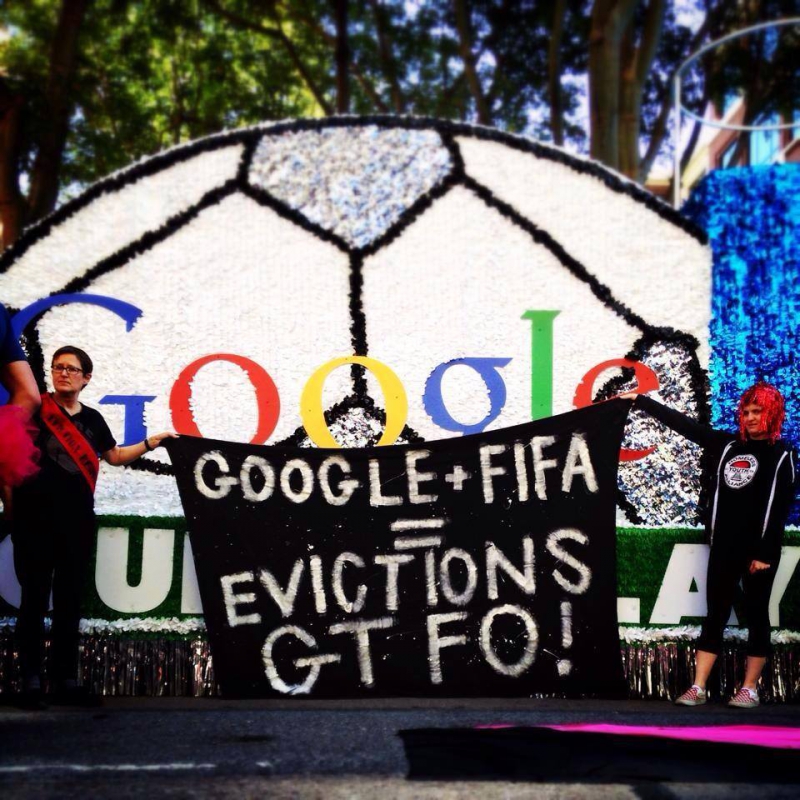 The next day, a group calling itself ‘Queer Class War’ blocked the Google FIFA float at the annual PRIDE parade. In a communiqué online they wrote:
The next day, a group calling itself ‘Queer Class War’ blocked the Google FIFA float at the annual PRIDE parade. In a communiqué online they wrote:
In solidarity with Brazilians protesting the FIFA Would Cup, on Sunday June 29th, a group of 12 queer radicals blockaded the Google FIFA Float at the San Francisco Pride Parade. “We couldn’t pass up the opportunity to connect issues of gentrification and evictions in the Bay Area with the violent displacement of Brazilians who live in the Favelas. The Google/FIFA float was a perfect target for direct action to raise awareness about these issues!”
The World Cup has violently evicted and even killed over 150,000 working class and poor people from their communities and the police have brutally repressed protests by Indigenous Warriors, Anarchists, Union Workers, and Homeless people. The night before the World Cup anarchist’s homes were brutally raided to intimidate the movement but they could not repress the mass uprising that has challenged every day of the world cup. El Sindicato dos Metroviários de São Paulo or Subway Workers Union of Sao Paulo was violently attacked by police when they went on strike against the World Cup and for better wages and benefits.
Get Involved
If you'd like to help with maintaining or developing the website, contact us.
Publish
Publish your stories and upcoming events on Indybay.



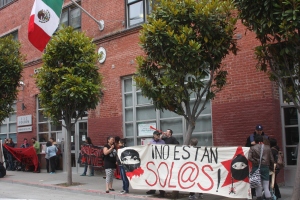 Also in May, people demonstrated in solidarity with the Zapatista movement which faced attacks from the Mexican State. In a
Also in May, people demonstrated in solidarity with the Zapatista movement which faced attacks from the Mexican State. In a  In July, actions began in the bay area organized in solidarity with the latest assault by Israel against those living in the Palestinian territories, which resisted with riots and street battles. In San Francisco, thousands of people participated in massive marches, although some protest organizers attempted to contain and manage the protests from becoming too uncontrollable. A post on
In July, actions began in the bay area organized in solidarity with the latest assault by Israel against those living in the Palestinian territories, which resisted with riots and street battles. In San Francisco, thousands of people participated in massive marches, although some protest organizers attempted to contain and manage the protests from becoming too uncontrollable. A post on  Out of these mass mobilizations, a call began to grow to organize a blockade of Israeli ships at the Port of Oakland. These actions were inspired in part by actions by the
Out of these mass mobilizations, a call began to grow to organize a blockade of Israeli ships at the Port of Oakland. These actions were inspired in part by actions by the  While Block the Boat was playing itself out, people were also
While Block the Boat was playing itself out, people were also 
 In October and November,
In October and November,  Also in November, marches and protests took place in solidarity with the 43 disappeared students in Mexico. Anarchist took part in these marches, and distributed a flyer stating, “It was the State! All power to the hooded ones!”:
Also in November, marches and protests took place in solidarity with the 43 disappeared students in Mexico. Anarchist took part in these marches, and distributed a flyer stating, “It was the State! All power to the hooded ones!”: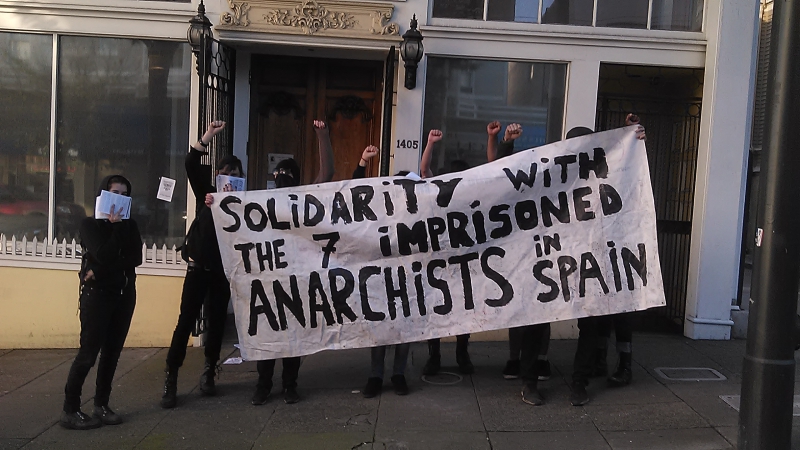 In December, anarchists carried out an action at the SF Spanish Consulate against attacks on the anarchist movement in Spain by the State and also for the passing of several draconian measures. A
In December, anarchists carried out an action at the SF Spanish Consulate against attacks on the anarchist movement in Spain by the State and also for the passing of several draconian measures. A  Building and Sustaining Autonomy
Building and Sustaining Autonomy
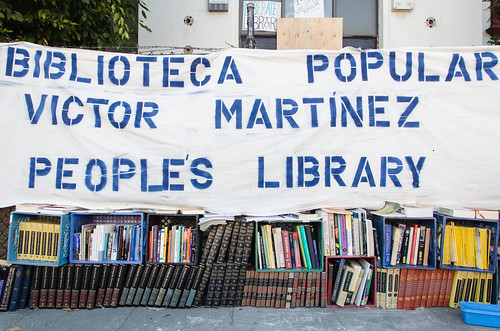 In East Oakland, people associated with Poor News Network launched various initiatives such as communal schools and homesteads, striving to create “
In East Oakland, people associated with Poor News Network launched various initiatives such as communal schools and homesteads, striving to create “ The racialized nature of these events is unavoidable. The family living at 625 is the last black family on the block. 23rd Street between Martin Luther King Jr. Way and Northgate Ave is a hotly contested area, right between rapidly gentrifying KONO and Uptown, and also sitting on the edge of west Oakland. The group who bought their house, 302EOF LLC, is one of several ominous limited-liability companies that have been buying numerous properties across the city, often flipping them for profit soon after. Along with bigger players such as REO Homes LLC (which owns another house on the block) and Community Fund LLC, this has been a driving force for gentrification. Investment groups and prospectors like these have been so successful in Oakland and elsewhere because they can pay cash for properties, so sellers don’t have to worry about loans from potential new homeowners.
The racialized nature of these events is unavoidable. The family living at 625 is the last black family on the block. 23rd Street between Martin Luther King Jr. Way and Northgate Ave is a hotly contested area, right between rapidly gentrifying KONO and Uptown, and also sitting on the edge of west Oakland. The group who bought their house, 302EOF LLC, is one of several ominous limited-liability companies that have been buying numerous properties across the city, often flipping them for profit soon after. Along with bigger players such as REO Homes LLC (which owns another house on the block) and Community Fund LLC, this has been a driving force for gentrification. Investment groups and prospectors like these have been so successful in Oakland and elsewhere because they can pay cash for properties, so sellers don’t have to worry about loans from potential new homeowners.  Organizers with the
Organizers with the  Nieto’s murder by police, anarchists began to hold weekly ‘
Nieto’s murder by police, anarchists began to hold weekly ‘ Long running radical spaces such as the Long Haul Infoshop, Bound Together Books, Modern Times, and Station 40 also continued to host events, reading groups, and staff open hours. Although in San Francisco some spaces such as Marcus Books and others
Long running radical spaces such as the Long Haul Infoshop, Bound Together Books, Modern Times, and Station 40 also continued to host events, reading groups, and staff open hours. Although in San Francisco some spaces such as Marcus Books and others  Small Anti-Fascist actions continued in 2014. In March, an anonymous communiqué on indybay.org took credit for an attack on Counter-Currents publishing, a ‘thinking man’s’ white nationalist book publisher located in San Francisco. At the time of this writing, it appears that Counter-Currents have uprooted itself to Southern California after pickets and repeated brickings. Also in March, an ‘Antifa Patrol’ was organized in San Francisco after sightings of skinheads roaming Market Street, although no boneheads were to be found. Several months later, anti-fascists infiltrated an event and made public the appearance of a Ukrainian Neo-Nazi in San Francisco who did a talk to other right-wing extremists.
Small Anti-Fascist actions continued in 2014. In March, an anonymous communiqué on indybay.org took credit for an attack on Counter-Currents publishing, a ‘thinking man’s’ white nationalist book publisher located in San Francisco. At the time of this writing, it appears that Counter-Currents have uprooted itself to Southern California after pickets and repeated brickings. Also in March, an ‘Antifa Patrol’ was organized in San Francisco after sightings of skinheads roaming Market Street, although no boneheads were to be found. Several months later, anti-fascists infiltrated an event and made public the appearance of a Ukrainian Neo-Nazi in San Francisco who did a talk to other right-wing extremists. Native struggles in the bay area persisted, as the Winneman Wintu tribe began to resist the raising of the Shasta Dam. In June, long time Ohlone organizer Luta was attacked and brutalized by police in San Leandro although his eventual charges were dropped. In October, in an “anarchist and indigenous collaboration,” a billboard was altered with the following communique released:
Native struggles in the bay area persisted, as the Winneman Wintu tribe began to resist the raising of the Shasta Dam. In June, long time Ohlone organizer Luta was attacked and brutalized by police in San Leandro although his eventual charges were dropped. In October, in an “anarchist and indigenous collaboration,” a billboard was altered with the following communique released: The Chevron oil refinery also remained a hot-button issue in the city of Richmond and was the scene of a variety of protests and actions. Also in 2014, Chevron started its news service, which attempted to promote a pro-Chevron slant on the news while the massive energy corporation backed a slew of candidates in local elections. Chevron went as far as to call one local progressive politician an “anarchist” and supporter of “Occupy Oakland” in one campaign designed to scare voters. Chevron candidates failed poorly in the election and fires continued at the refinery, keeping firming in the minds of the local population the massive eruption that took place in 2012. The continuing debacle in Richmond also happened behind the national backdrop of resistance to the movement of crude oil by rail, struggles to fracking and pipeline projects, as well as an ongoing drought in California.
The Chevron oil refinery also remained a hot-button issue in the city of Richmond and was the scene of a variety of protests and actions. Also in 2014, Chevron started its news service, which attempted to promote a pro-Chevron slant on the news while the massive energy corporation backed a slew of candidates in local elections. Chevron went as far as to call one local progressive politician an “anarchist” and supporter of “Occupy Oakland” in one campaign designed to scare voters. Chevron candidates failed poorly in the election and fires continued at the refinery, keeping firming in the minds of the local population the massive eruption that took place in 2012. The continuing debacle in Richmond also happened behind the national backdrop of resistance to the movement of crude oil by rail, struggles to fracking and pipeline projects, as well as an ongoing drought in California. Before the Ferguson rebellion spread to the bay area in the late summer of 2014, in the first half of the year we saw a continued war on black and brown communities and the growth of anti-police struggles in various cities. Protests, marches, freeway disruptions, and in some cases, small riots broke out over the police murder of Andy Lopez in Santa Rosa, Antonio Guzman in San Jose, Alex Nieto in San Francisco, a string of police killings in Salinas and Vallejo, and the police murder of Yanira Serrano-Garcia in Half-Moon Bay, among others. Actions also continued in the case of Kayla Moore, a transgendered woman who was murdered by Berkeley Police in 2013.
Before the Ferguson rebellion spread to the bay area in the late summer of 2014, in the first half of the year we saw a continued war on black and brown communities and the growth of anti-police struggles in various cities. Protests, marches, freeway disruptions, and in some cases, small riots broke out over the police murder of Andy Lopez in Santa Rosa, Antonio Guzman in San Jose, Alex Nieto in San Francisco, a string of police killings in Salinas and Vallejo, and the police murder of Yanira Serrano-Garcia in Half-Moon Bay, among others. Actions also continued in the case of Kayla Moore, a transgendered woman who was murdered by Berkeley Police in 2013. As the struggle in Santa Rosa was underway, in San Francisco in March police shot and killed Alex Nieto, a community college student studying to become a probation officer who worked nights as a security guard. While eating a burrito on Bernal Hill, someone called the police claiming a Latino man was armed with a gun. Police then arrived and unloaded a massive amount of bullets into Nieto, killing him. While initial media reports claimed that a man with a gun attempted to attack police who fired in self-defense, later it was revealed that Nieto was only armed with a taser which he carried for work. That night, over 100 people gathered in the Mission District and marched to the 850 Bryant jail in response to the killing and against plans to build a new SF jail. Police cars were vandalized and attacked and no arrests were made. A communiqué from the march posted online read:
As the struggle in Santa Rosa was underway, in San Francisco in March police shot and killed Alex Nieto, a community college student studying to become a probation officer who worked nights as a security guard. While eating a burrito on Bernal Hill, someone called the police claiming a Latino man was armed with a gun. Police then arrived and unloaded a massive amount of bullets into Nieto, killing him. While initial media reports claimed that a man with a gun attempted to attack police who fired in self-defense, later it was revealed that Nieto was only armed with a taser which he carried for work. That night, over 100 people gathered in the Mission District and marched to the 850 Bryant jail in response to the killing and against plans to build a new SF jail. Police cars were vandalized and attacked and no arrests were made. A communiqué from the march posted online read: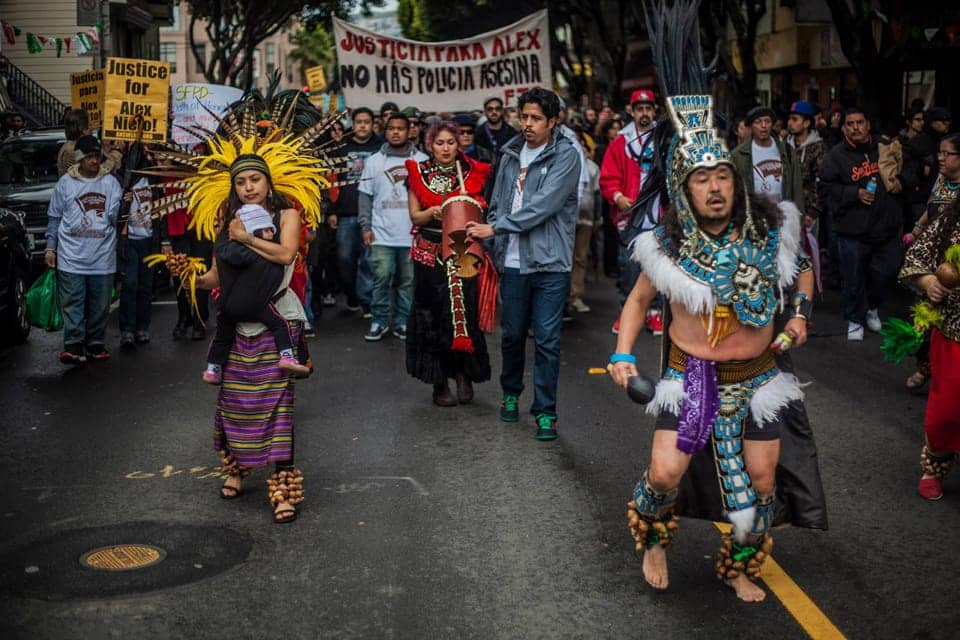 Several days later, the SFPD attempted to do damage control at a
Several days later, the SFPD attempted to do damage control at a  In Salinas, an agriculture hub and home to a large Latino population close to Monterrey a similar situation developed after
In Salinas, an agriculture hub and home to a large Latino population close to Monterrey a similar situation developed after  In Oakland, a
In Oakland, a  high-profile cases such as Alex Nieto and Andy Lopez or the Salinas riots, police in the Oakland area continued to harass and brutalize the general population through violence and beatings. Caught on camera numerous times during the year, police beat and arrested several people on BART and
high-profile cases such as Alex Nieto and Andy Lopez or the Salinas riots, police in the Oakland area continued to harass and brutalize the general population through violence and beatings. Caught on camera numerous times during the year, police beat and arrested several people on BART and 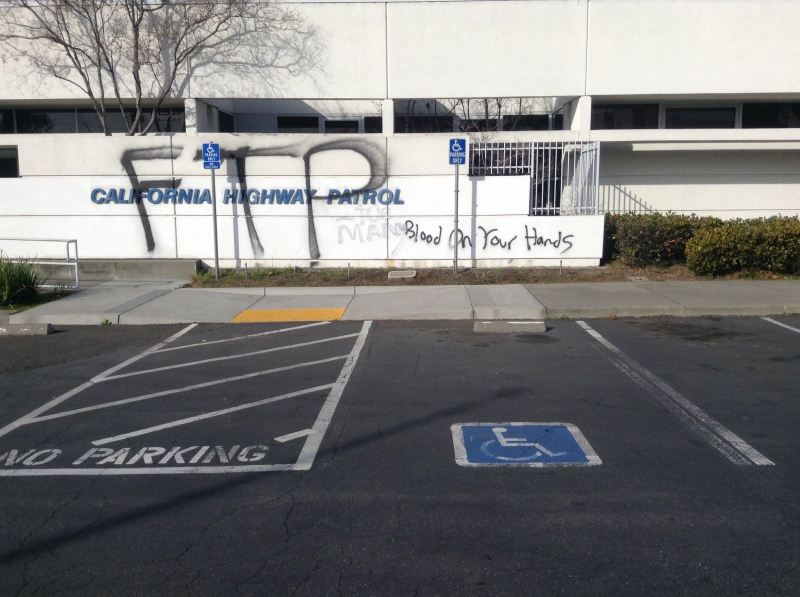
 Throughout the summer and into the fall, police murders continued. In June, San Mateo County Sheriffs shot an 18 year old special needs woman,
Throughout the summer and into the fall, police murders continued. In June, San Mateo County Sheriffs shot an 18 year old special needs woman,  In September, galvanized by the exploding Ferguson uprising and also images of militarized police firing weapons and tear-gas upon rioters, people took to the streets against the ‘
In September, galvanized by the exploding Ferguson uprising and also images of militarized police firing weapons and tear-gas upon rioters, people took to the streets against the ‘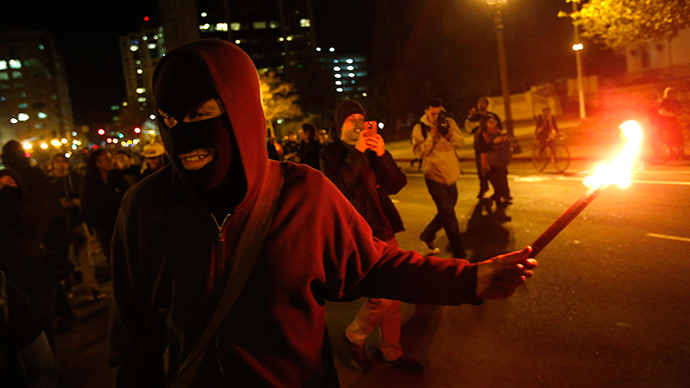 On November 24th, Oakland exploded in response to the grand jury decision to not indict Darren Wilson. The
On November 24th, Oakland exploded in response to the grand jury decision to not indict Darren Wilson. The 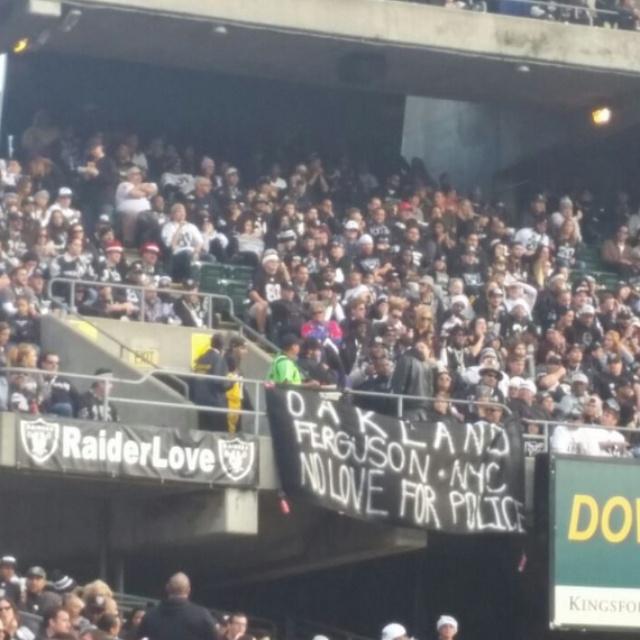 streets and attacked stores, looted alcohol, and defaced the Jack London square Christmas tree. On New Year’s Eve, hundreds took to the streets for a yearly noise demonstration outside of the Glenn Dyer Jail and once again clashes broke out with law enforcement. Throughout this time, hundreds and hundreds of people were arrested, with many still facing court dates and charges. Through the invaluable work of the Anti-Repression Committee, people have been bailed out, supported, and given access to lawyers. We encourage everyone to donate to their bail fund.
streets and attacked stores, looted alcohol, and defaced the Jack London square Christmas tree. On New Year’s Eve, hundreds took to the streets for a yearly noise demonstration outside of the Glenn Dyer Jail and once again clashes broke out with law enforcement. Throughout this time, hundreds and hundreds of people were arrested, with many still facing court dates and charges. Through the invaluable work of the Anti-Repression Committee, people have been bailed out, supported, and given access to lawyers. We encourage everyone to donate to their bail fund.
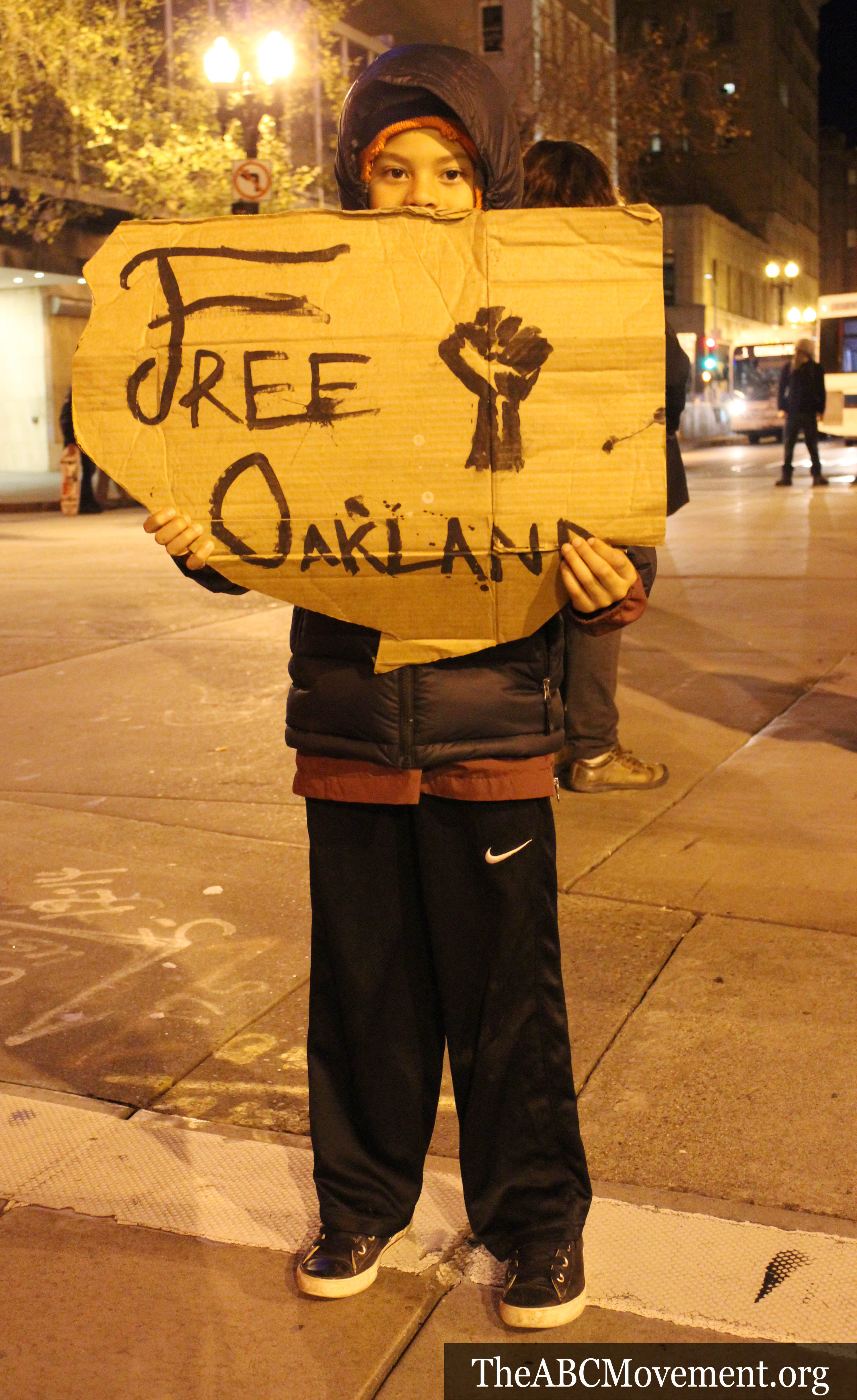 When we take to the streets. When we fight back in direct ways, in offensive ways, not just passive marches, boycotts or petitions, then something changes within us. Our spirits are awakened when we take back space, whether it be buildings, freeways, walls, parks, ect. Confidence is built through taking risks. And when confidence is built we can do it better and larger and deeper. We can start to imagine what it might be like to not live in fear of the backlash of the state. We can begin to imagine what it might be like to live without a state altogether. To be truly free and autonomous. To not just take back space for a few hours, but to really decolonize and live with the earth.
When we take to the streets. When we fight back in direct ways, in offensive ways, not just passive marches, boycotts or petitions, then something changes within us. Our spirits are awakened when we take back space, whether it be buildings, freeways, walls, parks, ect. Confidence is built through taking risks. And when confidence is built we can do it better and larger and deeper. We can start to imagine what it might be like to not live in fear of the backlash of the state. We can begin to imagine what it might be like to live without a state altogether. To be truly free and autonomous. To not just take back space for a few hours, but to really decolonize and live with the earth.  The anti-police rebellion in the bay is far from over; thus we do not want to comment too much, but know that this is certainly a historic year. However, we will say that several things seem to be clear. The current revolt has been informed by revolts in the past (Occupy, student occupation movement, Oscar Grant) as well as current conditions (militarized policing, gentrification, the economic crisis, environmental catastrophe). The youth that are in the streets today were in high school when they first saw people rioting for Oscar Grant or fighting the police during Occupy. Now, they are the ones in the street, walking out of class, and occupying freeways or a building. Attempts by self-appointed leaders to contain and direct the ‘movement,’ be they BAMN, the RCP, or a host of
The anti-police rebellion in the bay is far from over; thus we do not want to comment too much, but know that this is certainly a historic year. However, we will say that several things seem to be clear. The current revolt has been informed by revolts in the past (Occupy, student occupation movement, Oscar Grant) as well as current conditions (militarized policing, gentrification, the economic crisis, environmental catastrophe). The youth that are in the streets today were in high school when they first saw people rioting for Oscar Grant or fighting the police during Occupy. Now, they are the ones in the street, walking out of class, and occupying freeways or a building. Attempts by self-appointed leaders to contain and direct the ‘movement,’ be they BAMN, the RCP, or a host of 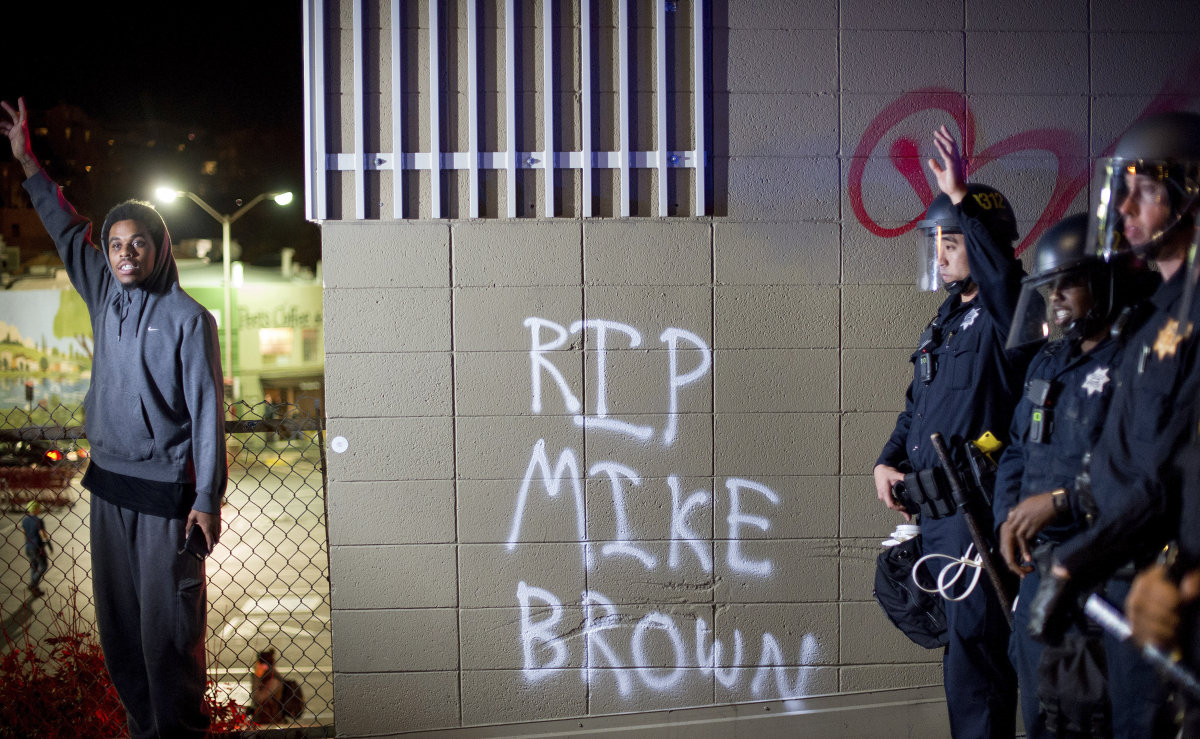 others, largely have not been successful. People have in their minds what they want to do, and often they are able to do it. While much has been said about “peace police” and vigilantes who have attempted to stop the looting and destruction of businesses in the name of ‘peaceful protest;’ these people have been totally ineffective at stopping the momentum. The militant street actions, along with the repression by the police of the protests, have only made things grow in scale. As an anonymous anarchist interviewed on KPFA stated:
others, largely have not been successful. People have in their minds what they want to do, and often they are able to do it. While much has been said about “peace police” and vigilantes who have attempted to stop the looting and destruction of businesses in the name of ‘peaceful protest;’ these people have been totally ineffective at stopping the momentum. The militant street actions, along with the repression by the police of the protests, have only made things grow in scale. As an anonymous anarchist interviewed on KPFA stated: 2014 was a historically explosive year. Riots raged, ports were blocked, workers walked off the job, free-ways were shut down, stores were looted, homes were squatted, and people took to the night in acts of destruction against systems of domination. The police also continued to murder people in the streets. The government attempted to expand surveillance and policing into every aspect of social life. The environmental situation continued to move closer to a dystopian reality – a reality openly admitted to by even ruling institutions. The elites attacked poor and working people at all possible angles. Through cuts and the
2014 was a historically explosive year. Riots raged, ports were blocked, workers walked off the job, free-ways were shut down, stores were looted, homes were squatted, and people took to the night in acts of destruction against systems of domination. The police also continued to murder people in the streets. The government attempted to expand surveillance and policing into every aspect of social life. The environmental situation continued to move closer to a dystopian reality – a reality openly admitted to by even ruling institutions. The elites attacked poor and working people at all possible angles. Through cuts and the  This government never was legitimate. It was a colonial project constructed on stolen land out of genocide and white supremacy that attempted to divide a nation of indigenous people, slaves, indentured servants, and workers all against each other as it grew into the most murderous destructive empire in human history. But for many now, the mask has been finally removed. This government is no longer legitimate; resistance to it is.
This government never was legitimate. It was a colonial project constructed on stolen land out of genocide and white supremacy that attempted to divide a nation of indigenous people, slaves, indentured servants, and workers all against each other as it grew into the most murderous destructive empire in human history. But for many now, the mask has been finally removed. This government is no longer legitimate; resistance to it is. Occupy was a moment in time where we, like millions across the world came together and found one another in public places that were taken over. Attempts were made to move the struggle forward and deepen it. From the broken bank windows, to the blocked ports, to the occupied and communally farmed plots of land – all of it pointed to future possibilities of what everyday people could do after choosing sides in a war. Yet for many, Occupy remained a cry to those in power to listen – to listen to their discontent and make changes within capitalism. In 2014, millions of people, especially the youth, realized that those in power know very well things are fucked – they simply don’t give a shit. Many people came to see that it was necessary to physically shut down and attack the systems of domination; not simply register discontent to it.
Occupy was a moment in time where we, like millions across the world came together and found one another in public places that were taken over. Attempts were made to move the struggle forward and deepen it. From the broken bank windows, to the blocked ports, to the occupied and communally farmed plots of land – all of it pointed to future possibilities of what everyday people could do after choosing sides in a war. Yet for many, Occupy remained a cry to those in power to listen – to listen to their discontent and make changes within capitalism. In 2014, millions of people, especially the youth, realized that those in power know very well things are fucked – they simply don’t give a shit. Many people came to see that it was necessary to physically shut down and attack the systems of domination; not simply register discontent to it. Against the backdrop of nihilism and despair that makes up the daily reality of modern life, people found joy in discovering what human bodies could do in the thousands and as individuals within these rebellious constellations. This is something that all of the journalists, all of the non-profit workers, all of the politicians in waiting, all of the “good allies” who attempted to attack and silence black people were never able to understand. In the struggles of 2014, they instead saw potential voters, subscribers to their newspapers, and obedient members to their organizations. We saw accomplices and co-conspirators. We saw possibilities of revolt spilling into all facets and avenues of social life. That’s why when people shut down trains and freeways, when they blocked the ports, when they broke through the windows of Smart and Final screaming, “This is for Oscar!,” when they attacked police cars – there were smiles on everyone’s faces. People found a common joy in attacking this world of misery and alienation; in shutting it down and make everything stop.
Against the backdrop of nihilism and despair that makes up the daily reality of modern life, people found joy in discovering what human bodies could do in the thousands and as individuals within these rebellious constellations. This is something that all of the journalists, all of the non-profit workers, all of the politicians in waiting, all of the “good allies” who attempted to attack and silence black people were never able to understand. In the struggles of 2014, they instead saw potential voters, subscribers to their newspapers, and obedient members to their organizations. We saw accomplices and co-conspirators. We saw possibilities of revolt spilling into all facets and avenues of social life. That’s why when people shut down trains and freeways, when they blocked the ports, when they broke through the windows of Smart and Final screaming, “This is for Oscar!,” when they attacked police cars – there were smiles on everyone’s faces. People found a common joy in attacking this world of misery and alienation; in shutting it down and make everything stop.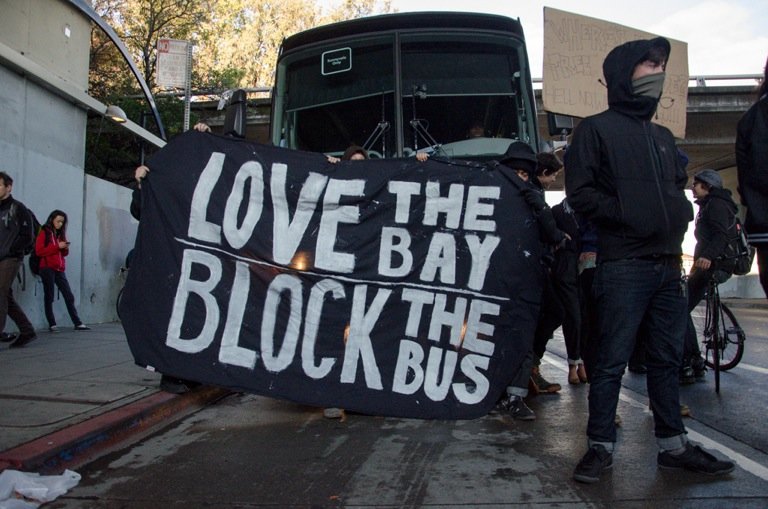 2014 was about people finding their power and the confidence to attack and refuse within that power. It was about the awakening of a generation of people told over and over again that they had no future. And while perhaps for now the riots have receded, we hope that this spirit carries itself back with you, dear reader. Into your workplace, into your groups of friends, into your neighborhoods, into your schools – everywhere.
2014 was about people finding their power and the confidence to attack and refuse within that power. It was about the awakening of a generation of people told over and over again that they had no future. And while perhaps for now the riots have receded, we hope that this spirit carries itself back with you, dear reader. Into your workplace, into your groups of friends, into your neighborhoods, into your schools – everywhere. But the question remains, will we continue to use these actions not only in the rebellions to come, but towards what end? Will it be to meet our current material needs and grow stronger as a force? Or will it simply degenerate into symbolic gestures that are ended when cosmetic changes are made by those in power? Will we use these new found weapons and capacities to begin to joyously play with the creation of new worlds, or let them fall from our hands, as the demands of work, traffic, family, smart phone, internet, and more work pull us back into the bullshit of everyday life.
But the question remains, will we continue to use these actions not only in the rebellions to come, but towards what end? Will it be to meet our current material needs and grow stronger as a force? Or will it simply degenerate into symbolic gestures that are ended when cosmetic changes are made by those in power? Will we use these new found weapons and capacities to begin to joyously play with the creation of new worlds, or let them fall from our hands, as the demands of work, traffic, family, smart phone, internet, and more work pull us back into the bullshit of everyday life. One thing is clear, we will never forget this year. A new standard has been set. We only hope to continue to raise it and learn from our shortcomings.
One thing is clear, we will never forget this year. A new standard has been set. We only hope to continue to raise it and learn from our shortcomings.